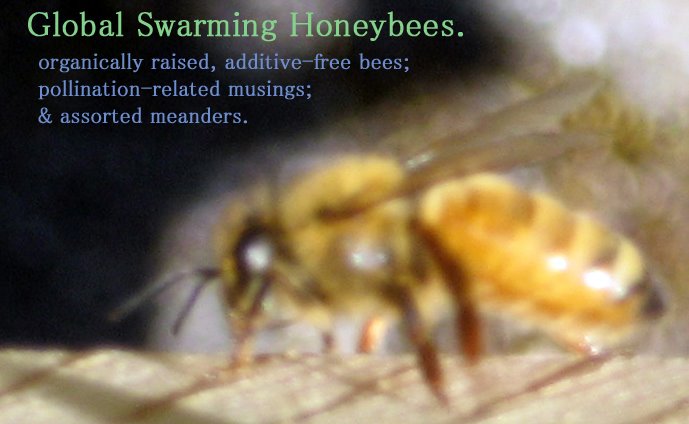
 The zinnias—in their "Different Brilliant Colors"—provide one of the garden's last nectar sources for the honeybees and other pollinators. Zinnia + borage + sunflowers + tomatillo blossoms = all that remains on the garden front, nectar-wise. (Fortunately, even after last week's light frost, the fields remain rich in goldenrod and aster, which the bees are working with frenzied effort as the foraging season winds down.)
The zinnias—in their "Different Brilliant Colors"—provide one of the garden's last nectar sources for the honeybees and other pollinators. Zinnia + borage + sunflowers + tomatillo blossoms = all that remains on the garden front, nectar-wise. (Fortunately, even after last week's light frost, the fields remain rich in goldenrod and aster, which the bees are working with frenzied effort as the foraging season winds down.)
This bumblebee captured my attention the other day, not only for its impressive size, but because it was slow-going, which made it possible for me to enjoy the sight of the morning sunlight illuminating its fuzzy exterior. Bumblebees are usually more skittish than honeybees, and quicker to buzz off, as it were, when the paparazzi arrives. 
See the pic below for a better look.



Some beekeepers become incensed when predators "get" their bees. Birds, for example, are described in some beekeeping guides as "pests" of the honeybee. So are frogs, which have enough troubles of their own without being maligned by beekeeping textbooks. I've even read posts from people on organic beek groups threatening to shoot cardinals or scarlet tanagers who "dare" to pick off their bees.
Please. That's the way the food chain crumbles. Yes, I'm saddened to see a bee taken by a spider or bird or whatever, but I also know that bees are no more exempt from the food chain system than the rest of us (lest we forget that we too become grist for the nature-mill, by and by). One reason Mother Nature, in her pretty much infinite wisdom, creates colonies consisting of tens of thousands of honeybees is that danger, predation, mortality are part of the game. Deal with it.
Besides, I like spiders. Is that so wrong?
9.25.2008
Zinnia Zap
Labels:
honeybee predators,
spider,
zinna
Subscribe to:
Post Comments (Atom)









1 comment:
Wow amazing pictures, Gerry. Thanks for posting them.
Post a Comment